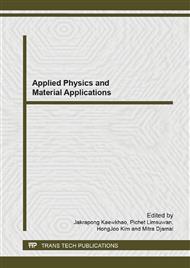[1]
H. Mahmoudi Chenari, L. Weinhardt, N.S. Rodriguez Lastra, M.A. Ernst, F. Reinert, M.M. Golzan and A. Hassanzadeh, Structural properties and x-ray photoelectron spectroscopic study of SnO2 nanoparticles, Mater.Lett. 85 (2012) 168-170.
DOI: 10.1016/j.matlet.2012.06.073
Google Scholar
[2]
T. Krishnakumar, R. Jayaprakash, N. Pinna, A.R. Phani, M. Passacantando and S. Santucci, Structural, optical and electrical characterization of antimony-substituted tin oxide nanoparticles, J. Phy.Chem.Solids. 70 (2009) 993-999.
DOI: 10.1016/j.jpcs.2009.05.013
Google Scholar
[3]
K.Chang Song and Y.kang, Preparation of high surface area tin oxide powders by a homogeneous precipitation method, Mater.Lett. 42 (2000) 283-289.
DOI: 10.1016/s0167-577x(99)00199-8
Google Scholar
[4]
S.Mosadegh Sedghi, Y.Mortazavi and A. Khodadadi, Low temperature CO and CH4 dual selective gas sensor using SnO2 quantum dots prepared by sonochemical method, Sen.Actuat. B-chem. 145 (2010) 7-12.
DOI: 10.1016/j.snb.2009.11.002
Google Scholar
[5]
S.Xiaolan, L. Dongfeng, Z. Yimeng, D. Yi, L. Mei, W. Shunkui, H. Xi and Q. Yixin, Grain Growth Kinetics of SnO2 nanocrystals Synthesized by Precipitation Method, Journal of Wuhan University of Technology-Mater, Sci.Ed. (2010) 929-934.
DOI: 10.1007/s11595-010-0122-z
Google Scholar
[6]
J.F Huang, X.R. Zeng, L.Y. Cao, N.B. Xiong, Preparation of Y2BaCuO5 nanoparticles by a co-precipitation process with the aid of ultrasonic irradiation, J.Mmater.Process.Tech. 209 (2009) 2963-2966.
DOI: 10.1016/j.jmatprotec.2008.07.001
Google Scholar
[7]
S. Takenaka, R. Takahashi, S. Sato, T. Sodesawa, F. Matsumoto and S. Yoshida, Pore size control of mesoporous SnO2 prepared by using stearic acid, Micropor.Mesopor.Mat. 59 (2003) 123-131.
DOI: 10.1016/s1387-1811(03)00304-4
Google Scholar
[8]
J.S Lee and S.C Choi, Solvent effect on synthesis of indium tin oxide nano-powders by a solvothemal process, J.Eur.Ceram.Soc. 25 (2005) 3307-3314.
DOI: 10.1016/j.jeurceramsoc.2004.08.022
Google Scholar
[9]
A. Hassanzadeh, B. Moazzez, H. Haghgooie, M. Nasseri, M. Maqsood Golzan and H. Sedghi, Synthesis of SnO2 nanopowders by a sol-gel process using proponol-isopropanol mixture, Central European Journal of Chemistry, 6(4), (2008)651-656.
DOI: 10.2478/s11532-008-0072-x
Google Scholar


